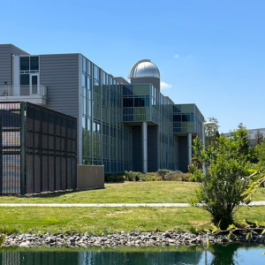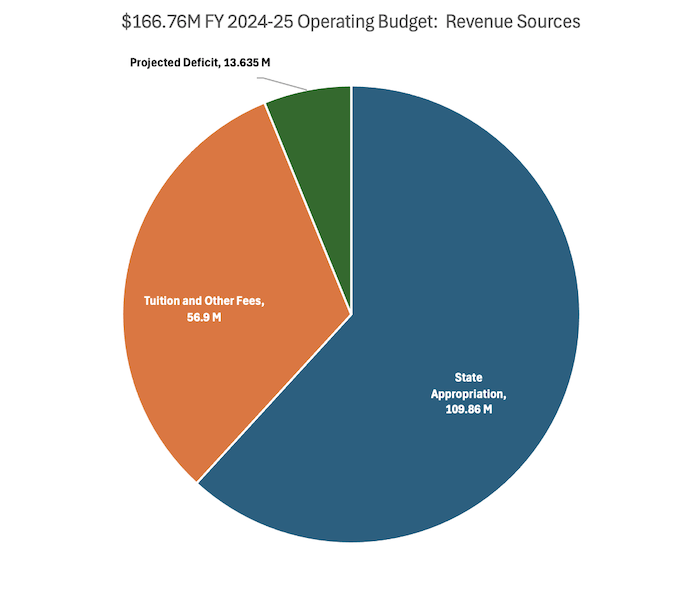Understanding Our Budget
Our budget outlines how funds are allocated to various areas of the University. Tuition and state appropriation form the majority of our revenue, while expenses are primarily composed of salaries, health insurance, and unfunded campus costs. See the complete picture of our budget.

Stanislaus State Budget Communications & Forums
- UBAC Open Meeting Nov. 20, 2025
- Updated: 2025-26 Budget Update and Our Path Forward
- Budget Update: What It Means for Our Campus Community
Download recent presentations from the University Budget Forums

2026-27 CSU Operating Budget
Presented by the CSU Board of Trustees Committee on Finance.
This presentation includes:
- An overview on the state’s fiscal condition
- Recap of state funding assumptions
- Update on the CSU budget situation
- Examination of potential CSU federal funding issues
- Discussion on the continuing state and federal concerns
CSU Operating Budget Plan Presentation Slides
Additional Information from the Chancellor's Office

Budget Advocacy
Whether you're a student or alum whose future was transformed by Stan State, a faculty or staff member shaping lives every day, or a community partner who sees the ripple effects of our graduates, your perspective helps decision-makers know the value of investing in us.
What our Community is Asking
Gain insights into how funds are allocated across the University, the challenges we face and the strategic initiatives being considered to address our financial realities.
There are four major pressures on our budget.
First, the recent employee compensation increases, though well-deserved and negotiated at the system level, have resulted in a substantial cost increase of $19.7 million for Stanislaus State by 2025-26. This $19.7 million structural deficit anticipated for 2025-26 already takes into account the $4.6 million provided from the Chancellor's Office. The Current Year deficit is currently estimated to be $13.635 million.
Second, the structural deficit increases from $13.635 million in the current year to $19.7 million in 2025-26 due to that additional $8.1 million slated to be taken from our budget. The 2025-26 Budget also takes into account the estimated savings of $5 million from the recent Voluntary Separation Incentive Program (VSIP).
Third, fewer full-time equivalent students (FTES our measure of state enrollment) will result in decreased state support and tuition dollars. Enrollment decline is a nationwide trend in higher education.
Fourth, high inflation from 2021 through 2023 increased the cost for almost everything the university does. Benefits like healthcare and pension contributions typically outpace inflation for the rest of the economy, often by a significant margin.
Hard to say at the moment. Part of the answer is it depends on how aggressively we act over the next two years. That is a matter of urgent discussion in shared governance.
In planning for the 2024-25 fiscal year, each Division was asked to conduct a budget reduction exercise to reduce their operating base budget by 5 percent. Based on the latest projections, the total operating baseline budget needs to be reduced by an amount closer to 10 percent.
All divisions will need to develop plans to balance their budgets. The scale is just too large to spare any division its share of the cuts.
However, we will also need to address the fact that some areas in the university are critically underfunded, jeopardizing their mission and the mission of other areas that rely on them. There may be some programs and specific offices/departments that remain as is even as we scale back spending overall.
Liquidating all investments is not a realistic option. First, that option only works once and then you are back in the same situation next year with fewer resources. Second, the university does not hold much in invested savings. What we do have saved are funds that will be spent later in the year or a minimal reserve (about one month in emergency backup).
Most long-term investments are held by the Stanislaus State Auxiliary Services and Stanislaus State Foundation. Auxiliary operations are intended to be self-sufficient, so funds deposited with the State of California’s Local Agency Investment Fund help provide modest returns for things like food services, childcare, or the bookstore. Almost all Foundation funds are restricted and committed to an intended purpose upon receipt, so investments are used to generate returns for things like scholarships or to enhance specific academic programs without draining university funds intended for classes, student support, and operations.
No. However, growth will help to a point. The California State University (CSU) sets enrollment targets for Stanislaus State. We get around six dollars from the state for every three dollars that comes from tuition.
Currently, the CSU is funding us for our full enrollment target. However, in calculating tuition revenue, the university is budgeting with the assumption of being 4.0 percent below target. We are striving to do better than that.
Shortfalls and waitlists are not strongly related. Courses that have waitlists tend to be online courses, courses that are scheduled in prime teaching blocks, or courses being taught by preferred instructors. It is also the case that a particular elective is very popular so students want to take it even though there might be electives that fulfill the same requirement. Many of our students who put themselves on a waitlist have a full schedule. If the desired (for reasons listed above) course opens, they will drop a course and add the waitlisted course. It is important to understand that overall, waitlists are course specific and enrollment shortfalls are general.
If we are 400 FTES short of target, that FTES is distributed throughout a schedule of about 2500 courses per semester. The overall impact of the shortfall may be only to reduce course enrollments by very small numbers. For instance, there may be courses that enroll at 35 when we are at target but only 30 when we are down by 4%.
Yes. Stanislaus State budgeted this semester with the assumption of being 4.0 percent below CSU enrollment target. As a result, we have .5 percent fewer sections compared to last year, and 3.8% fewer sections compared to Fall ’22, and 5.03% fewer sections compared to Fall ‘21. We are focusing on a student-centered course schedule that aligns with available resources. We are also working to align our enrollment with funded CSU system targets.
Stanislaus State is committed to following the Collective Bargaining Agreement (CBA) with the California Faculty Association in course assignments.
The university first assigns courses to tenured/tenure-track faculty followed by lecturers per the order of assignments in the CBA. Three-year full-time faculty have priority when it comes to offering courses followed by three-year part-time lecturers.
If there is additional work available, then the work is offered to full-time one-year lecturers followed by part-time lecturers staffing the remaining classes.
Operating Budget
The following chart shows our operating budget and how it is divided into the following categories:
State Appropriation, Tuition and Other Fees, and Projected Deficit.
$166.76M FY 2024-2025
Operating Budget: Revenue Sources
| Revenue Sources | Amount |
|---|---|
| Total Operating Budget | $177.76M |
| State Appropriation | $109.86M |
| Tuition and Other Fees - CO Estimate | $56.9M |
| Projected Deficit | ($13.635M) |
Changes to Revenues
FY 2024-2025
| Revenues | Amount |
|---|---|
| 5% State Appropriation Increases (compact) | $9,730,000.00 |
| State Budget One-Time Reduction | ($1,736,000.00) |
| Tuition From 6% Increase - CO Estimate | $3,352,000.00 |
| Tuition Shortfall, 4% below target | ($5,992,822.00) |
| Total | $5,353,178.00 |
Changes to Expenses
FY 2024-2025
| Expenses | Amount |
|---|---|
| 23-24 Compensation Increase Funded by University - CO Estimate | $3,095,000.00 |
| 24-25 Compensation Increase Funded by University - CO Estimate | $5,485,000.00 |
| State University Grant (SUG) Financial Aid - CO Estimate | $1,294,000.00 |
| Health/Insurance Premiums and Mandatory Commitments | $3,761,000.00 |
| Total | $13,635,000.00 |
| Projected Budget Deficit | $13,635,000.00 |
Updated: November 18, 2025

